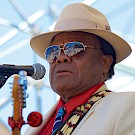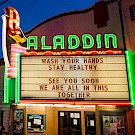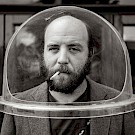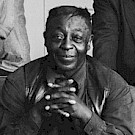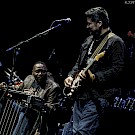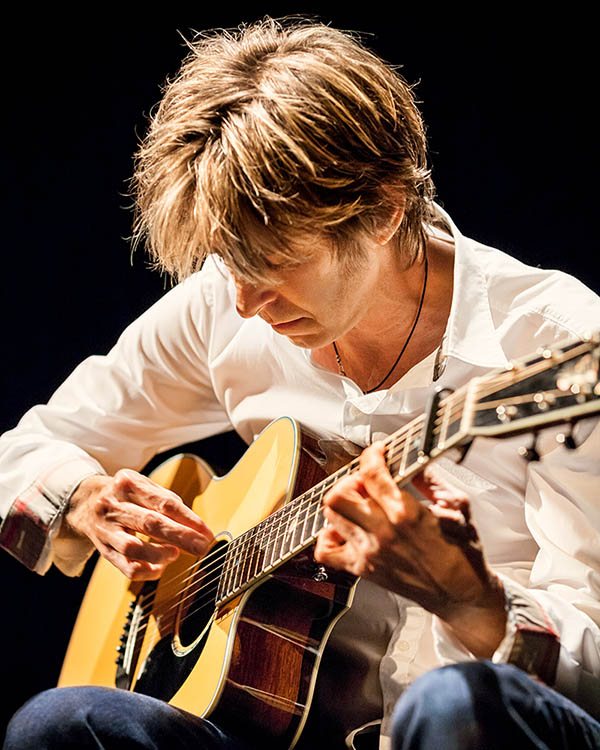 Long one of the instrument’s brightest talents, Eric Johnson remains one of a handful of players to have mastered the multifaceted dialect of rock guitar and recast it in his own image; a neologism rooted in the marriage of Jimi Hendrix's incendiary hard blues and the spacious, widely intervallic chord concepts of Ted Greene.
Long one of the instrument’s brightest talents, Eric Johnson remains one of a handful of players to have mastered the multifaceted dialect of rock guitar and recast it in his own image; a neologism rooted in the marriage of Jimi Hendrix's incendiary hard blues and the spacious, widely intervallic chord concepts of Ted Greene.
Following a rapid ascent to international renown upon barrelling through a white-hot one-hour set on Austin City Limits in 1988, Johnson, an Austin native, would subsequently deviate only sporadically from what was showcased that evening. Tones, Johnson’s debut, and its successor, 1990’s platinum-selling Ah Via Musicom, as well as later efforts, largely channeled the blues-inflected rock and pyrotechnic guitar work that quickly became Johnson’s hallmark.
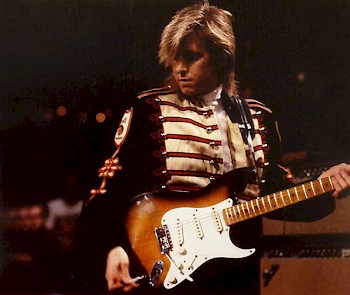 Johnson at Austin City Limits in 1988Johnson would, however, reveal a latent gift for fingerstyle playing in the vein of Chet Atkins and Jerry Reed, two figures often cited as influences, and an earnest flair for the cream of classic American folk. Seven Worlds, an unreleased LP once destined to have been Johnson’s solo debut, features an early arrangement of “A Song for Life,” an original composition for acoustic guitar. “Song for George,” another such piece, appears on Ah Via Musicom, now widely considered Johnson’s signature effort.
Johnson at Austin City Limits in 1988Johnson would, however, reveal a latent gift for fingerstyle playing in the vein of Chet Atkins and Jerry Reed, two figures often cited as influences, and an earnest flair for the cream of classic American folk. Seven Worlds, an unreleased LP once destined to have been Johnson’s solo debut, features an early arrangement of “A Song for Life,” an original composition for acoustic guitar. “Song for George,” another such piece, appears on Ah Via Musicom, now widely considered Johnson’s signature effort.
On tour, Johnson has displayed a propensity for working acoustic numbers into his setlists, a longstanding practice perhaps dating to a 1984 Austin City Limits performance when Johnson played both his own “A Tribute to Jerry Reed” and Paul Simon’s “April Come She Will” on a vintage Martin D-45. Later footage shows Johnson’s heartfelt treatment of “Kathy’s Song”—another of Simon’s gems—during a standout date at New York City’s Bottom Line club in the early 1990s.
On EJ, his latest release, Johnson finally draws the curtain on this second, and perhaps more fundamental (as the title may suggest), element of his musical identity, showcasing the array of talent he has hinted at since the inception of his solo career. Johnson’s acoustic playing, while always strong, has markedly developed since that time; the more fully delineated bass, comping and melody lines of “Mrs. Robinson” suggest he has benefited greatly from touring with the likes of contemporary acoustic heavyweights Andy McKee and Peppino D’Agostino. Similarly, the lilting delicacy of Johnson’s voice, which can be buried in rock settings, is nicely suited to the nuance and elegant instrumental accompaniment of “All Things Are” and “Wonder”—both Johnson originals.
Speaking in advance of his Tuesday, January 31 solo performance at Portland’s Aladdin Theater, Johnson talks writing and recording EJ, and his comfort with performing stylistically variable material in solo settings. He also extemporizes at length on the importance of spontaneity and imperfection in the recording process, ultimately speaking to a desire to meld the acoustic and electric sides of his music—and an anticipated follow-up to EJ.
I know that acoustic folk has served as something of a creative touchstone throughout your career; tracks in that style have consistently appeared on your records since the late 1970s, when Seven Worlds was recorded. What led you to release a complete album of songs for acoustic guitar and piano in 2016?
Yeah, I’d included an acoustic song here and there on all my electric records over the years, and garnered these acoustic songs. Every once in awhile, I’d do an acoustic tour kind of for fun, just to get out and play and do a different thing. It seems like it’s well-received, and I enjoy it because it’s been part of my appeal; to play piano and write songs on an acoustic. But I’d never really displayed it to audiences very much.
At some point, I got so busy doing this tour, or that tour, or this record, and I never got around to doing the acoustic record. I went, “At some point, I’ve got to sit down and do this.” So, amidst other things, I just said, “Stop. I’m going to do this record. Otherwise, I’ll never make it.” And, I think, in doing that, I’ve set something in motion that I can enhance and improve on. Because it’s a good medium; you look at the value of the song and carrying music with what you’ve got in one moment, with one instrument, rather than rely on all the extra adornment.
When I saw you perform in 2013, you played a solo set of acoustic and piano songs—not too far removed from what’s on the album, actually—before the electric band came on stage. I get the sense the broader concept for EJ has been on your mind for a long time.
Yeah, yeah.
Has it been challenging to find continuity onstage when switching instruments and playing styles? Or are you feeling pretty comfortable performing everything now?
Yeah, I think I am. But it is a challenge for me. I know that when I walk on stage, I’ve got to pull the whole song off with one guitar and one voice, or one piano and one voice, and the whole thing has got to work when you don’t have any other stuff to rely on. So, it’s a little bit of a challenge, but I think it’s a good challenge. It’s teaching me a lot about where to place priorities on stuff.
Just briefly, can you walk me through your background on the acoustic guitar?
I got an acoustic as a graduation present from my parents when I was 17, and that’s the first time I ever started playing acoustic.
As soon as I started playing, I realized that the electric technique was not what I wanted to do on an acoustic, because I didn’t think it really—I think it was kind of like a different instrument. In order for me to pull off what I needed to do on an acoustic, I couldn’t approach it the same way. So, I had to start teaching myself to fingerpick. And that was a slow process.
For me, learning to fingerpick well was an arduous thing. It’s been a process of many years of trying to learn to play. But, I’d just keep playing at home, and whenever I got a song together, I’d include it on an electric record. All the while, I was trying to increase my vocabulary with fingerpicking and independence as far as playing chords and bass notes, or melody and chords at the same time. Those aspects of acoustic can be pretty challenging. Unless you’re Tommy Emmanuel; then, I guess, you can do it in your sleep. [Laughs]
Right. Structurally, your arrangements of “Mrs. Robinson” and “The World is Waiting for the Sunrise” actually seem reminiscent of something Tommy Emmanuel might do. It sounded like you were having fun playing those, too.
Yeah, we actually cut that [“The World is Waiting for the Sunrise”] live with my friend Doyle [Dykes]. He’s a great player. It’s funny, we cut that live and we were having a lot of fun in the studio just cutting up.
When you went into the studio, were you looking to impart the exacting or precise qualities you had sought earlier in your career? Or did you try to let go a little more than in the past?
I pretty much let go. The only thing I was trying to get on the record was to make sure there was the right kind of energy; that it had some excitement and energy. Other than that, it was kind of like, “Whatever.” I just went old school with a couple of Neumann mics.
If I have to single out my taste on acoustic, it’s going to trend more towards really old-school James Taylor, Joni Mitchell, Crosby, Stills & Nash; kind of just a microphone in front of the guitar. I love the nakedness of that sound and the expansive freedom you can find within that limitation.
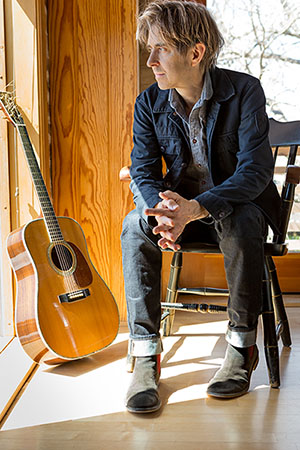 Have you become something of a believer in “first-take magic,” and that it can underlie the power of a recording? Has that been true in your experience?
Have you become something of a believer in “first-take magic,” and that it can underlie the power of a recording? Has that been true in your experience?
Absolutely—absolutely. No question about it.
Sometimes, in the back of my head, I always knew that it was. But you have to believe that it’s very important and try to rise to the occasion to make it happen. It’s not just words, it’s the power behind the words or the power behind the sound. You might get it all perfect just going through the motions, but it’s not going to have the same spirit.
There’s things about this acoustic record that still bug me. As a part of my journey, I purposefully let go. I said, “Screw this. I’m not going to take my usual tack of beating this to death.” So maybe I left little glitches, or stuff speeds up. There are tracks I played too slow or too fast, but they’re what they were. I just started thinking that if I keep falling back on this thing—that I could always just go back and fix it—I’m not going forward. When you start doing that, only then, I think, do you start getting stronger in that path, because you started that path. So, my thought was, “It is the way it is. I’ll try to play better next time. I’ll play this song a little slower, or I’ll do this.” There were a few things I fixed, but for the most part, that’s just all performance.
There’s a certain thing that really made me realize how strong that is. What really blew my mind is not only getting that first or second take, but getting that vibe. It’s like, “What’s your mood when you’re recording?” It’s amazing that that bleeds into it. A painter can paint the exact same picture, but if he’s mad, just the way it is, is different, you know what I mean? Whatever our mood is, or wherever our intentions or our well-being sit at any point, it seems to permeate everything we do or say. And so, it was like, “Wow, I’ve got to rethink this whole thing. It’s not as clandestine as I used to think it was.”
Has arriving at, or yielding to, that understanding been a long process?
Yeah, longer than it should have at my age. I wish I’d figured this out a long time ago. I just thought smoke and mirrors could get you one hundred percent there. And there’s nothing wrong with overdubbing, or adorning, or fixing stuff. I think it’s a matter of what you place as your priority, and making sure you don’t trade it for something of lesser value, you know?
I’ve been guilty of doing that a lot in the past. It’s just that I would trade—like, you mentioned the first-take magic. I would trade that in for getting something just perfect. And it’s not like you’re getting it perfect; everyone gets on this bandwagon of saying perfect is bad. It’s really not. I mean, you listen to [Jascha] Heifetz or Itzhak Perlman or Franz Liszt. Maybe perfect is the wrong word. Trying to achieve a high-water mark of excellence, there’s absolutely nothing wrong with that. It’s just a matter of if you obviously traded it for something too valuable to get rid of. Then that’s not good.
“One Rainy Wish” was another track that stood out. It’s one of my absolute favorite Jimi Hendrix songs, and one I know you’ve been performing since at least the '80s—and possibly earlier. At what point did you start to hear it as an acoustic piece?
The people involved with Jimi Hendrix were doing this project where they were getting all these different people to pick a song and do an acoustic version of it. So, I picked that song and I presented it to them. I don’t think the record ever came out; it kind of got waylaid. So, I thought, “Well, heck. I’m going to put this on my own record.” Actually, I did two completely different versions: I did a piano version that’s on this record, and I also did a classical guitar version of it, which I have a finished recording of. I actually want to put it on the volume two acoustic record I’m going to try to make this summer.
It’s a totally different approach to the tune. But, yeah, I think I was inspired by it. It’s such a beautiful song, and he was such a great songwriter. And that’s what I think makes it so timeless—more than his guitar prowess.
It’s one of those songs that I could never really envision being played other than the way Hendrix himself played it. But I thought the way the song’s dreamy character was channeled through the arrangement—especially the vocals—was a really creative twist. How did the arrangement process play out?
Well, I recorded it with acoustic guitar bass and drums. And then I thought, “Well, this is okay. Just doesn’t have much.” Then I went back and started adding piano to it, and got the idea of what direction to take it in. I tried to fan it out into those kinds of voicings. I thought the song already had those cool kinds of voicing in it, but I thought, “Maybe I’ll just try to pronounce them a little more clearly.” I really tried to push a little more with piano voicings, and then it started getting more of an ethereal, semi-jazz kind of thing to it. And once I started fooling around with that, I started getting the idea, “Wow, this’ll work.” That inside thing was really just kind of from fooling around. I started hearing this mandolin-like rolling, picking thing over those chords. Once I did that, I went, “Wow! That’s kind of bluegrass-y.” I just ran with that and then put a couple of guitars and that bluegrass motif thing on the inside.
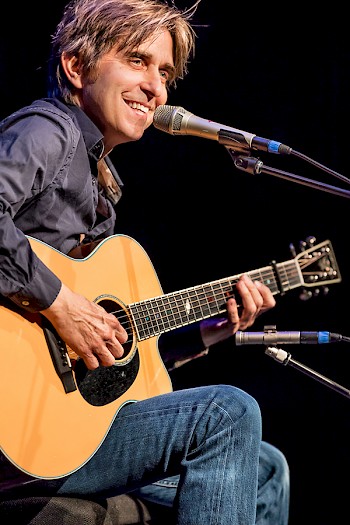 So it was something you worked out primarily by feel.
So it was something you worked out primarily by feel.
Yeah, yeah. Whatever felt right.
The songs of Simon & Garfunkel seem to parallel those of Jimi Hendrix in that you’ve performed or recorded them since the early days of your career. As an artistic touchstone, they appear similarly fundamental. Can you speak to the depth of your relationship to their work?
You know, when I was a teenager, my friends and I would sit around and we’d listen to those records all the time, like Wednesday Morning, 3 A.M. and Sounds of Silence—when I wasn’t listening to Cream or Jimi Hendrix. It was kind of more of the soundtrack of our lives; Simon & Garfunkel and even some Joan Baez, and early Joni Mitchell, and James Taylor and Crosby, Stills & Nash. I wore those records out, like, if I was driving around in a car on a winter day—it was really way more a part of me than the world has ever known, or expected, I guess.
But it’s always been a huge part of me. Maybe it was not the best judgment on my part, but when I had a little bit of success with Ah Via Musicom, I thought, “Okay, this is what everybody wants to hear” and jumped on the—whatever it is—guitar bandwagon. That was this somewhat-okay rocket ship until it started to fizzle down and turn into some kind of weird thing that was almost a caricature of itself, you know? [Laughs.] I mean, I still think there’s places to take the electric guitar, like Explosions in the Sky—I think they’re totally happening. But for the most part, it kind of turned into a bombastic thing.
But, you know, I think I have to take responsibility—I’m the one that just kept riding the thing. I don’t know why I never really showed what was really a part of me. I mean, the electric guitar thing was definitely part of me, I think I just showed a fractional part of what I do. I guess that’s what I mean.
You've actually spoken about that tension before. Would it be accurate to attribute it to the sort of duality you just spoke to, and to the process of reconciling these acoustic and electric sides into a unified musical identity?
Yeah, I think so. And I think I’ve come to terms with it. I think it’s—you know, I can choose to live in a glass bubble of self-entitlement, like, “Why isn’t everybody thinking this is cool or that?” Or you can go, “I do what I do, and I’ll try to do the best that I can,” and realize that in that, there’s a whole sea of incredible musicians and there’s so much out there. I think now, we’re more aware of it. All you need is YouTube, and then there’s somebody in Madagascar who’ll blow your mind. And they’ve been there all along—we just haven’t been privy to it. But, I think getting rid of all that luggage of self-entitlement lessens the frustration, and it really boils down to doing the absolute best you can.
Even then, I have friends who send me recordings that are so great, I can’t believe people aren’t freaking out over them. The music business has changed so much, I guess it’s just part of it. It’s like, “What are your stats with YouTube and this and that.” It’s just so different—just having something really great doesn’t automatically give you validity, I don’t know.
But, bringing it back home, just trying to come up with something as valid and emotionally insightful and impactful as you can, and letting all that other stuff go will let some of that frustration go, too.
Do you foresee the acoustic and electric elements of your music remaining separate for the duration of your career? Or, alternately, is EJ something of a step towards forging that unification?
I think it’ll be an amalgam. I’d like to approach the electric thing differently now. I’d like to try to cut more stuff live in the studio with the electric, as well; try to use what I’ve learned for the electric, too, because it works with all types of music. And maybe this is because of my age—although I don’t think so because I talk to kids all the time who agree with me—but I can listen to a lot of new music, some of which is absolutely brilliant, and then I can put on a Sam Cooke song that, like you said, they got on the first take. And you’re just completely blown away with the vibe. It’s like, “Oh, my god!” It’s almost as if you’re returning to the reality or to the home base of what the best frequency of music really is, you know? To hit that beautiful, pinnacle nerve center, it’s awesome.
So, I think it’s indisputable that, whatever you do—unless you’re doing electronic or dance music, which is a whole other thing, and that’s cool—you can’t go wrong with trying to try to paint a picture or capture a moment and be spontaneous.
In a sense, that’s the nexus of art, isn’t it?
Right, yeah. I don’t think paint by numbers is ever going to be the Mona Lisa.

